 German Reich (1942)
German Reich (1942)
Self-Propelled Assault Gun – 360 to 366 Built
Encountering an ever-increasing number of well-armed and protected enemy tanks caused turmoil in the German Army. The German tanks and anti-tank weapons of 1941 were barely managing to keep enemy armor at bay. Due to a lack of industrial capacity, the Germans had only two options for a quick response, either build improvised anti-tank vehicles or improve the firepower of existing designs. Following the second solution, the StuG III would be adopted for a completely new role it was initially not designed for. Its short barrel gun would be replaced with a longer 7.5 cm gun which greatly improved its overall firepower. Thanks to its relatively cheap price, slight silhouette, fully protected superstructure, and a new gun, along with well-trained and motivated crews, this created a highly deadly vehicle. The first in the line of the long barrel vehicles was the StuG III Ausf.F.

The Need for a Bigger Gun
During the invasion of the Soviet Union, in 1941, the German anti-tank and tank units came into contact with the KV-series and the T-34-76 tanks. To their shock, the available anti-tank and tank guns proved almost powerless against these new Soviet tanks. Luckily for the Germans, they were well-trained, experienced, and better supplied in the early stages of the war in the Soviet Union. The Soviet tanks lacked logistical support, were often poorly used and led, and their crews were not sufficiently trained. But, as time went on, the Soviets began to rapidly increase the production of their tanks, and their crews and command staff gained more and more experience. Thus, the Germans slowly lost the advantage that they had in the early stages of Operation Barbarossa. Relying solely on experience and better tactics was not enough, and stronger armament was needed.
Given the urgency and the lack of production capacity, introducing completely new guns was not possible in a short time frame. The first improvement attempts made regarding the 7.5 cm guns (used on the Panzer IV and StuG III) consisted of the introduction of newly shaped charge rounds in late 1941. While they could penetrate the thick armor of the Soviet tanks, their effectiveness was quite limited by the rather poor ballistic characteristics of such rounds. This was not a proper solution, and a more reliable weapon was needed. Another possibility was to improve the muzzle velocity of the existing guns. This could be achieved by simply introducing longer gun barrels and larger propellant charges. This is what the German industry desperately tried to achieve in late 1941.
The development of the 7.5 cm longer barrel gun actually started before the war. The original StuG III L/24 gun was primarily intended for dealing with infantry and fortified targets. It is often forgotten that it was also capable of piercing 40 mm of armor at some 500 m distance. This was more than enough to deal with most tank designs of the pre-war era. Even before the war, the Waffenamt Prüf 4 (English: Army Weapons Agency of the ArtilleryBranch) was interested in further increasing the anti-tank capabilities of this gun. In early August 1938, Rheinmetall and Krupp were approached and instructed to begin working on a new longer gun that was to be used for the anticipated new Verstaktes (English: improved or enhanced) StuG vehicle.

Krupp’s development would lead to the creation of the 7.5 cm L/41 gun (sometimes referred to as L/40). The prototype of this new gun was completed by late April 1940. During firing trials, an average muzzle velocity of 675 m/s was achieved. Initial reports also mentioned some troubles with spent cartridge ejection from the gun after firing. Sometime in May 1940 (or even earlier), this gun would be installed on a modified Panzer III Ausf.F chassis that received a completely redesigned mild steel StuG III superstructure. Given the large 7.5 cm rounds used, it was necessary to greatly extend the superstructure size. It was tested at the Jüterbog artillery training center and was demonstrated to Hitler at the end of March 1941. There was a major interest in this weapon, and thus, troop trials were ordered to see how this gun performed. If accepted for service, the production of the new vehicle was estimated to begin in the second half of 1942. Unfortunately, what happened to the Krupp L/41 armed StuG III vehicle is unknown. This Krupp project was officially canceled in November 1941.

Rheinmetall-Borsig meanwhile was focusing on developing an anti-tank weapon which was basically an enlarged version of the 5 cm PaK 38. They succeeded in this, creating the 7.5 cm PaK 40 L/46 gun. It would prove to be an effective tank destroyer and would see service up to the end of the war. This gun could not directly be used on the StuG III without a series of modifications, due to the vehicle’s cramped interior. Both Krupp and Rheinmetall-Borsig were instructed by the Waffenamt Prüf 4 to work on this project. First, the ammunition was shortened and received a thicker shell casing. This greatly simplified the crew loading process, as they could easily handle the new 7.5 cm rounds. The recoil of the gun also had to be reduced. This led to the creation of the 7.5 Kanone 44 cm L/46 later in March 1942, renamed to 7.5 cm StuK (Sturmkanone) 40 L/43 gun.
Once the first few prototypes of this gun were available at the start of 1942, these were installed inside modified StuG III Ausf.E vehicles for testing. The firing tests were carried out in April 1942. While the overall gun’s performance was overall satisfactory, the ejection of spent cartridges proved somewhat problematic, but in time, this problem would be resolved. Regarding the vehicle’s design, it necessitated only some minor changes to StuG III Ausf.E’s original form. These mainly involved adding new ammunition racks, improving the ventilators, and some other minor changes.

Name
In line with its predecessors, this vehicle received the name Gepanzerte Selbstfahrlafette für Sturmgeschütz 7.5 cm Kanone Ausführung F. (English: Armored Self-Propelled Assault Gun 7.5 cm version F.) Later in the war, the name would be slightly changed to Gepanzerte Selbstfahrlafette für 7.5 cm Sturmgeschütz 40 Ausführung F (English: Armored Self-Propelled Vehicle 7.5 cm Assault Gun 40 version F.). The basic charge involved adding the Sturmgeschütz 40 designation, which referred to its main armament. In the sources, both Sd.Kfz.142 and Sd.Kfz.142/1 special designation numbers are attributed to this vehicle. The latter probably referred to the L/48 armed StuG III Ausf.F.
Production
Following the successful testing of the first prototypes, a production order for the new StuG III Ausf.F was given. The production began in late March and ended in September 1942. During this period, some 366 (chassis number 91035 to 91400) Ausf.Fs would be built by Alkett. Some authors, such as D. Nešić (Naoružanje Drugog Svetsko Rata-Nemačka), mention that the number of vehicles built was 360.

Design
In order to put the Ausf.F into production as soon as possible, very little was done regarding its overall design in comparison to the previous version. The most obvious changes were the long gun and the ventilation port which was placed on top of the superstructure.
Hull
The StuG III Ausf.F’s hull design was unchanged compared to the Ausf.E, with the front-mounted drive unit, central crew compartment, and rear-positioned engine. A small change to the hull was the deletion of the two front-mounted headlights, with their armored covers. Instead of them, a simpler Notek headlight was placed at the center of the front upper hull armor. Note that this change was implemented late into production (June 1942), so most vehicles would have had the older headlight configuration.
Suspension and Running Gear
The torsion bar suspension remained the same. It consisted of six small road wheels, three return rollers, the front drive wheel, and the rear-positioned idler.

Engine
The StuG III Ausf.F was powered by a twelve-cylinder, water-cooled Maybach HL 120 TRM engine providing 265 hp @ 2,600 rpm engine. The weight increased to 23.2 tonnes from the previous 22, slightly affecting the overall drive performance. With that engine the StuG III Ausf.F could reach a maximum speed fo 40 km/h and, 20 km/h cross-country. For example, the operational range was reduced from the original 160 to 140 km on good roads, and from 100 to 85 km off-road. The shapes of the engine compartment hatches were also changed.
Superstructure
A number of changes were made to the superstructure in order to accommodate the larger gun. The front gun opening was slightly enlarged. On top of the central part of the superstructure, a protected ventilation port was added. This was necessary, as the increased propellant charge created more exhaust gasses, which could be dangerous for the crew. In addition, in rarer cases, the opening for the gun sight was covered by a small mesh cage.


Starting from August 1942, a small number of the newly produced StuG III Ausf.Fs received a modified front superstructure. The angle of the upper two plates above the driver (and opposite of him) was increased. This provided better protection, but also strengthened the whole construction. Identifying this feature is not always possible, as this part of the StuG III superstructure was often covered by concrete added by its crews.




Armor Protection
The early versions of the StuG III were some of the best-protected German armored vehicles of the time, thanks to their 50 mm thick frontal armor. During their first year in service, little was done to increase this. The StuG III’s armor and low silhouette were more than enough to protect the vehicle.
The first attempt to improve the StuG III’s armor was introduced on the Ausf.D version, increasing the face-hardening of the frontal armor plates. Given that the StuG IIIs operating in the Soviet Union were increasingly used in anti-tank roles (as, in most cases, nothing else was available), the original frontal armor thickness was deemed insufficient when engaging enemy tanks armed with 76.2 mm guns. Hitler himself insisted that the Ausf.F it should be increased up to 80 mm and issued a direct order for this to be implemented on 7th May 1942).
This armor thickness increase was not randomly chosen. The weight of the 80 mm thick front plates would not have greatly influenced StuG III’s overall driving performance. The introduction of these thicker plates, on the other hand, would have caused delays in production at a critical time for the Germans. To avoid this, as a temporary solution, 30 mm of armor plates were to be welded or, more often, simply bolted on the StuG III’s already existing 50 mm frontal armor.
Otherwise, the side and rear armor thicknesses remained unchanged. These were somewhat thinner, at 30 mm. The top armor was 10 mm, while the top of the engine compartment was slightly thicker, at 16 mm. The crews themselves would add all kinds of stuff that they could get their hands on to their vehicles in the hope of further increasing the protection. Adding concrete on the upper front superstructure appears to have been somewhat common among StuG III crews.



Armament
The StuG Ausf.F was rearmed with the 7.5 cm StuK 40 L/43 gun. This offered a huge improvement in anti-tank capabilities in contrast to the earlier 7.5 cm StuK 37 L/24 gun. Installation of the new gun was possible without any major problems, despite its larger size. The 7.5 cm StuK 40 had a semi-automatic breech with a vertical sliding block and was electrically fired. Having a semi-automatic breech meant that, after firing, the spent cartridge would self-eject, thus increasing the overall firing rate. It had an elevation of -6° to +20° (these numbers differ between sources), while the traverse was 10° in both directions.
For engaging direct targets, a Sf1.ZF1a gun sight was used. For indirect fire, either the Rundblickfernrohr 32 or 36 were used. These sights were directly connected to the gun, which meant that, during barrel movement (either elevation or traverse), they moved with it.
The large recoil cylinders were placed above the gun and were protected by a box-shaped armored deflector guard. The breach could be quite easily removed from the gun barrel if needed. To the rear of the breech, a protective recoil shield was placed. In addition, a canvas bag for spent ammunition was placed under the gun breach. The early 7.5 cm StuK 40 L/43 guns were usually equipped with the early ball-shaped muzzle brake. Later models received the improved double-chambered muzzle brake.



The new gun could use several different types of ammunition. These were the 7.5 cm SprGr Patr 34 high-explosive round, PzGr Patr 39 anti-tank round, NbGr Patr smoke round, and the Gr Patr 38 HL/B and C-shaped charge rounds. In addition, there was also the rare 7.5 cm PzGr Patr 40 tungsten-cored anti-tank round. This particular round was issued in limited numbers and designed to be used against the most heavily protected tanks. Lastly, there was an inferior version of this round, named 7.5 cm PzGr Patr 40(W). Instead of tungsten, its core was replaced with unhardened steel. While it could be produced in greater numbers, it was not that common, as its overall anti-tank performance was weaker than that of the standard anti-tank rounds.
| Type of ammunition | Velocity | Armor penetration at 100 m | At 1 km (sloped at 30°) |
|---|---|---|---|
| PzGr Patr 39 | 790 m/s | 106 mm | 80 mm |
| Gr Patr 38 HL/B and C* | 450 m/s | 75 mm | 75 mm |
| PzGr Patr 40 | 990 m/s. | 143 mm | 97 mm |
| PzGr Patr 40(W) | 990 m/s | 80 mm | 63 mm |
* Their ballistic shape was not optimal, so even when a direct hit was made, this did not guarantee that the round would penetrate the target’s armor. In many cases, it simply bounced off, doing nothing to the target.
With the new rounds, it was necessary to redesign the ammunition storage racks inside the new StuG IIIs. The standard ammunition load consisted of 44 rounds. According to B. Carruthers (Sturmgeschütze Armored Assault Guns), an additional 40 rounds could be stored inside the vehicle’s floor. Later in production, the ammunition storage was increased to 54 rounds. The crews of some vehicles simply removed the storage racks, which provided room to add additional rounds. It is worth mentioning these had slightly shorter cartridges compared to those of the towed 7.5 cm PaK 40. This was necessary due to the StuG III’s rather cramped interior.


Despite the need for improved anti-tank weapons, the production of the 7.5 cm L/43 was quite limited. The main reason for this was the introduction of the longer L/48 gun of the same caliber. Thus, only some 120 Ausf.F vehicles were armed with the shorter guns, the remaining being equipped with the later gun. This often leads to misconceptions that the StuG III Ausf.F vehicles were armed with the L/43, while the later F/8 was solely armed with the L/48, which is not true.

For self-defense, like on the previous StuG III versions, the Ausf.F was provided with a 7.92 mm MG 34 machine gun, which was operated by the loader. No machine gun shield was provided for the loader’s protection. The ammunition load for the MG 34 was 600 rounds. In addition, two MP38 or 40 submachine guns and hand grenades were also carried inside.

Crew
The crew of these vehicles consisted of four: commander, driver, loader, and gunner. The loader was positioned to the right of the gun and the remaining crew was placed opposite. The driver was positioned on the left front side of the hull. Just behind the driver was the gunner, and right behind, the commander.
Distribution to Units
During the war, the Germans rarely fully supplied new equipment directly to frontline units. They instead focused on equipping newly created units at home. The StuG III Ausf.F was no exception to. Most vehicles produced would be allocated in limited numbers to as many StuG III equipped units as possible. It was quite common to see mixed units equipped with older and newer vehicles. It would take nearly two years to fully equip most units with the better-armed StuG IIIs.

In rarer cases, whole units would be equipped with this vehicle. This was the case with the 640th Sturmartillerie Batterie (Eng. assault gun battery). Way back in May 1940, this StuG III unit was attached to the Panzergrenadier Division Großdeutschland. Unlike other similar StuG III units, which were attached to divisions depending on the combat needs, the 640th Battery would be permanently attached to the Großdeutschland Regiment under the new name 16th Assault Gun Battery. Due to casualties suffered on the Eastern Front, this regiment was recalled to Germany to be reformed. The 16th Assault Gun Battery was disbanded and its old equipment was reallocated to other units, while its personnel was transported to the artillery training center at Jüterbog. To supplement the manpower, the men from the 192nd Assault Gun Battalion were also transported to this center in April 1942. There, these men would be used to create the new Großdeutschland Assault Gun Battery, which was to be fully equipped with the StuG III Ausf.F. In total, 22 vehicles were to be provided to this unit, with 7 in each of its three batteries and one to act as a command vehicle.

In Combat
The first combat engagement of the StuG III Ausf.F was carried out by the Grossdeutschland Assault Gun Battery. This unit was sent to the ‘East’ as part of the new German offensive toward Stalingrad. They claimed to have destroyed 41 Soviet tanks during the brief period of 28th June to 7th July 1941.. Despite having superior anti-tank performances, they were mostly used in engaging fortified enemy positions. This can be seen in the ammunition counts used during this time. Some 910 high-explosive rounds were fired, in comparison to 431 armor-piercing shells. Both the KV-1 and the T-34-76 could be quite easily penetrated frontally at ranges of 600 m. There were no major issues with the spent cartridge extraction of the new guns. On the other hand, the ammunition supply was insufficient, forcing the StuG III crews to carefully select their targets.

The 667th Abteilung (Eng. battalion), which served as part of the Army Group Centre in the area of the Chleppen bridgehead also saw success against enemy armor. They helped the German defenders turn back a Soviet tank attack in early August 1942. In the engagement, they destroyed some 19 T-34 tanks. Later, at the end of August, the unit was repositioned to Rzhew. There, in a four-day engagement, the StuG IIIs managed to destroy 83 Soviet tanks. The commander of the 3rd Battery, Klaus Wagner, was credited with the destruction of 18 tanks. As he was severely wounded during this engagement, he was replaced by Oblt. Baumann. On 9th September, the Soviets launched another offensive with some 50 T-34 tanks. Their opponents had only 5 StuG III vehicles left. Despite being greatly outnumbered, the StuG IIIs managed to inflict huge damage on the Soviet armor and infantry. The Soviets lost 33 tanks, while the Germans lost all but one StuG III. As it was severely depleted, the 667th Battalion was moved to the rear for replacement and recuperation.
Six days later, on the 15th of September, the Soviets attacked once more. Without waiting for the remaining units to respond to the Soviet attack, Hugo Primozic from the 2nd Battery, along with two more vehicles, moved to stop the enemy. He prepared a well-selected ambush position, from which he engaged the advancing T-34 tanks. The StuG IIIs managed to destroy several T-34s, when they were fired upon by a KV-1 (or a KV-2, depending on the source) tank. Hugo’s vehicle received a direct hit, but the StuG III’s armor withstood the enemy round. His crew responded by firing a few rounds at the KV-1, before finally stopping the heavy tank. Hugo’s StuG turned back to engage the incoming T-34’s tanks. Destroying one T-34, blowing its turret off, it forced another T-34 to turn back. When the Soviet attack was repulsed, the Germans claimed the destruction of 24 T-34 and KV-1 tanks. Hugo Primozic would go on to become credited with the destruction of some 60 Soviet tanks by the end of 1942. The 667th Battalion also saw huge success while operating the StuG III Ausf.F’s, destroying 438 Soviet tanks during 1942, despite having only 21 vehicles in its inventory. Of course, it is worth mentioning that all combat records regarding destroyed vehicles were often exaggerated, used for propaganda purposes, or wrongly documented (this is characteristic of all warring parties in the Second World War to various degrees). The huge number of destroyed enemy tanks claimed does not necessarily need to be true.
Another example was the 224th Battalion, which participated in the battles around Stalingrad. A StuG III commanded by Kurt Pfreundtner managed to allegedly single-handedly destroy 9 T-34 tanks in early September 1942.
The majority of the produced StuG III Ausf.Fs would see service on the Eastern Front, where they were desperately needed. They would be most dominant in 1942, before slowly being replaced by the later-built versions.
A number of Ausf.Fs were also used on other fronts. For example, the 303rd Battalion operated in Finland during 1944. Some found their way to Italy as part of the 1st Fallschirm-Panzer Division Hermann Göring. Tracking them down is rather difficult, as they were greatly outnumbered by the later mass-produced StuG III Ausf.G.



Modifications and Variants
Fahrschul Sturmgeschütz
The Ausf.F was not used for any major modifications. Some of them were allocated to training centers, like the one in Jüterbog. Although other training vehicles had their guns removed or replaced with dummies, this does not seem to have been the case with the StuG Ausf.Fs. They would be used in this manner up to the end of the war. Some vehicles had their armament replaced or even removed.


Tropen Sturmgeschütz
A number of StuG III Ausf.Fs received specially designed air filters, usually located on the right side of the engine compartment. These and other similarly modified vehicles were intended to be used in dusty climates, such as North Africa (none of the Ausf.Fs were used there) or in the southern parts of Russia.

The StuH 42 Modifications
At the end of 1942 and the start of 1943, several StuG III Ausf.Fs were modified to be used as test vehicles for the anticipated new series of 10.5 cm howitzer-armed StuGs.

Surviving StuG Ausf.F
Today, only one StuG III Ausf.F is known to have survived the war. It is now located at the Australian Armour and Artillery Museum. This vehicle belonged to the 244th Battalion which saw service at Stalingrad.

Conclusion
The introduction of vehicles, such as the StuG III Ausf.F (and the Panzer IV Ausf.G), armed with the longer 7.5 cm gun was a game changer on the battlefields in the Eastern Front in 1942. The previous year, the Germans had trouble dealing with enemy armor, which was shown to be almost immune to their fire. The introduction of better guns basically overcame this Soviet advantage in armor and the enemy tanks could quite effectively be destroyed at range.
While it was initially present in small quantities, rapid increases in production over the following year led to the better-armed StuG IIIs being used in ever-increasing numbers. Starting with the StuG III Ausf.F in 1942, the StuG III would become the most important German anti-tank vehicle up to the end of the war, even though it was not meant for this role.
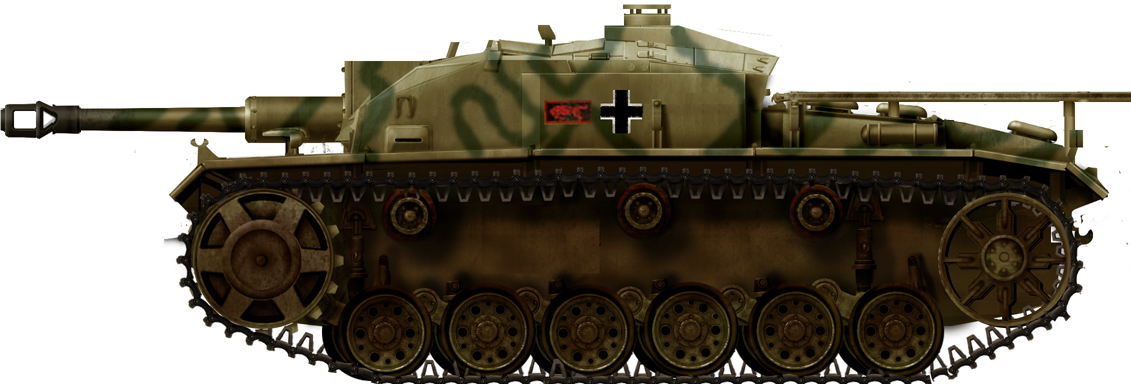
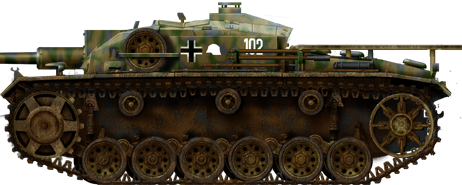
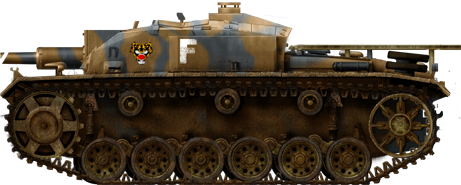

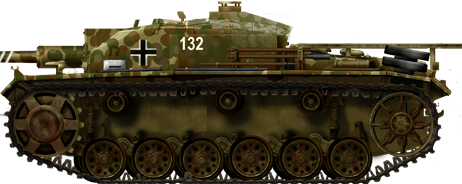
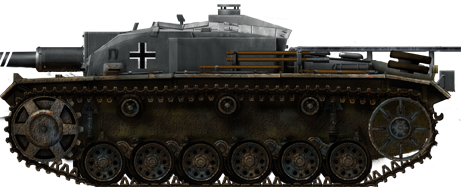
| Gepanzerte Selbstfahrlafette für 7.5 cm Sturmgeschütz 40 Ausführung F Technical specification | |
|---|---|
| Name | Gepanzerte Selbstfahrlafette für 7.5 cm Sturmgeschütz 40 Ausführung F |
| Crew | 4 (commander, gunner, loader, and driver) |
| Weight | 23.3 tonnes |
| Dimensions | Length 5.38 m, Width 2.92 m, Height 1.95 m |
| Engine | Maybach 120 TRM 265 hp @ 200 rpm |
| Speed | 40 km/h, 20 km/h (cross-country) |
| Range | 140 km, 85 km (cross-country) |
| Primary Armament | 7.5 cm L/43 or 48 |
| Elevation | -10° to +20° |
| Superstructure armor | front 30+50 mm, sides 30 mm, rear 30, and top 10-16 mm |
| Hull armor | front 30+50 mm, sides 30 mm, rear 30 mm, and the top and bottom 15 mm |
Sources
D. Doyle (2005). German military Vehicles, Krause Publications.
D. Nešić, (2008), Naoružanje Drugog Svetsko Rata-Nemačka, Beograd
Walter J. Spielberger (1993) Sturmgeschütz and its Variants, Schiffer Publishing Ltd.
T.L. Jentz and H.L. Doyle (1999) Panzer Tracts No.8 Sturmgeschütz
T.L. Jentz and H.L. Doyle (2006) Panzer Tracts No.3-2 Panzerkampfwagen III Ausf. E, F, G, H.
D. Nešić, (2008) Naoružanje Drugog Svetskog Rata-Nemačka, Beograd
P. Chamberlain and H. Doyle (1978) Encyclopedia of German Tanks of World War Two – Revised Edition, Arms and Armor press.
H. Scheibert (1994) Panzer III, Schiffer Publishing
Walter J. Spielberger (2007) Panzer III and its Variants, Schiffer Publishing Ltd.
B. Carruthers (2012) Sturmgeschütze Armored Assault Guns, pen and Sword
M. Healy (2007) Panzerwaffe Volume two,Ian Allan
T. Anderson (2016) Sturmartillerie Spierhead Of the Infantry, Osprey Publishing
T. Anderson (2017) Sturmgeschütz Panzer, Panzerjäger, waffen-SS and Luftwaffe Units 1943-45, Osprey Publishing
K. Sarrazin (1991) Sturmgeschütz III The Short Gun Versions, Schiffer Publishing
F. Gray (2015) Post War Panzers German Weapons in Czech Service, Guideline Publications
F. V. De Sisto (2008) German Sturmartillerie at War Vol.I, Condor Publication
A. T. Jones (2016) Images of War German Assault Guns and Tank Destroyers 1940-1945, Pen and Sword

One reply on “Gepanzerte Selbstfahrlafette für 7.5 cm Sturmgeschütz 40 Ausführung F (Sturmgeschütz III Ausf.F)”
“Although other training vehicles had their guns removed or replaced with dummies, this does not seem to have been the case with the StuG Ausf.Fs. They would be used in this manner up to the end of the war. Some vehicles had their armament replaced or even removed.”
Can someone please explain this statement? Did they remove guns or not?